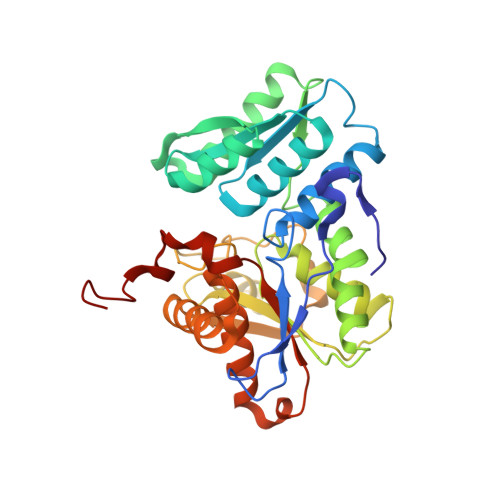Investigational Studies on a Hit Compound Cyclopropane-Carboxylic Acid Derivative Targeting O -Acetylserine Sulfhydrylase as a Colistin Adjuvant.
Annunziato, G., Spadini, C., Franko, N., Storici, P., Demitri, N., Pieroni, M., Flisi, S., Rosati, L., Iannarelli, M., Marchetti, M., Magalhaes, J., Bettati, S., Mozzarelli, A., Cabassi, C.S., Campanini, B., Costantino, G.(2021) ACS Infect Dis 7: 281-292
- PubMed: 33513010
- DOI: https://doi.org/10.1021/acsinfecdis.0c00378
- Primary Citation of Related Structures:
6Z4N - PubMed Abstract:
Antibacterial adjuvants are of great significance, since they allow the therapeutic dose of conventional antibiotics to be lowered and reduce the insurgence of antibiotic resistance. Herein, we report that an O- acetylserine sulfhydrylase (OASS) inhibitor can be used as a colistin adjuvant to treat infections caused by Gram-positive and Gram-negative pathogens. A compound that binds OASS with a nM dissociation constant was tested as an adjuvant of colistin against six critical pathogens responsible for infections spreading worldwide, Escherichia coli , Salmonella enterica serovar Typhimurium, Klebisiella pneumoniae , Staphylococcus aureus , methicillin-resistant Staphylococcus aureus , and Staphylococcus pseudintermedius . The compound showed promising synergistic or additive activities against all of them. Knockout experiments confirmed the intracellular target engagement supporting the proposed mechanism of action. Moreover, compound toxicity was evaluated by means of its hemolytic activity against sheep defibrinated blood cells, showing a good safety profile. The 3D structure of the compound in complex with OASS was determined at 1.2 Å resolution by macromolecular crystallography, providing for the first time structural insights about the nature of the interaction between the enzyme and this class of competitive inhibitors. Our results provide a robust proof of principle supporting OASS as a potential nonessential antibacterial target to develop a new class of adjuvants and the structural basis for further structure-activity relationship studies.
- P4T Group, Department of Food and Drugs, University of Parma, Parco Area delle Scienze 27/A, 43124 Parma, Italy.
Organizational Affiliation:





















